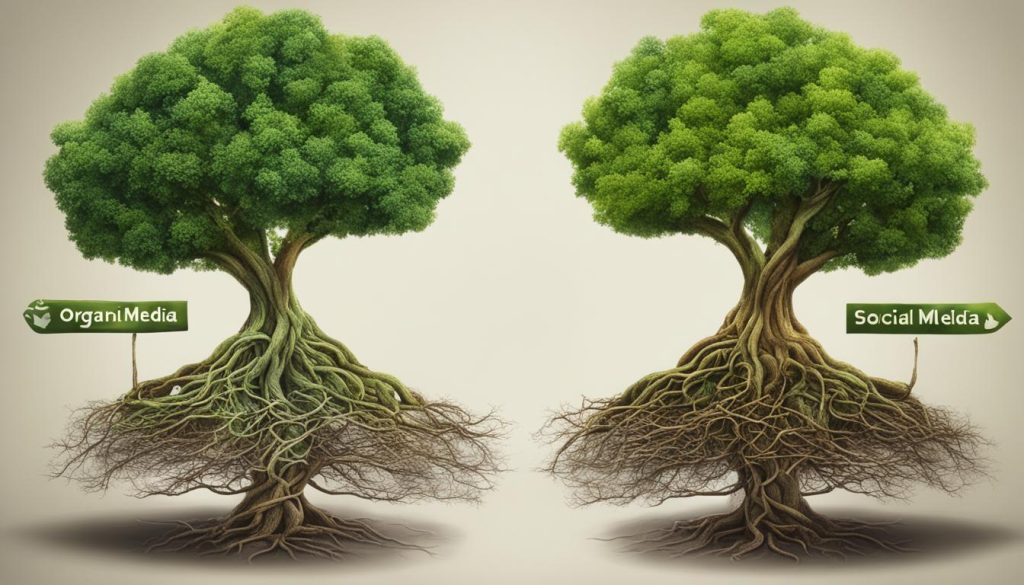In today’s digital age, social media has become a powerful tool for businesses to connect with their target audience and drive growth. When it comes to social media marketing, two main approaches dominate the landscape: organic and paid. Both have their strengths and advantages, but which strategy delivers better results for businesses? Let’s explore the benefits of organic social media and the advantages of paid social media to find out.
Key Takeaways:
- Organic social media is effective in raising brand awareness and driving customer engagement.
- Paid social media offers targeted audience reach and lead generation opportunities.
- A hybrid strategy combining organic and paid social media can deliver maximum results.
- Measuring ROI is essential for both organic and paid social media efforts.
- Businesses should evaluate their goals and resources to determine the optimal mix of strategies.
The Strengths of Organic Social Media
In today’s digital landscape, organic social media has emerged as a powerful strategy for businesses to connect with their audience on a more personal level. Unlike paid social media, which relies on advertising spend to reach target demographics, organic social media utilizes content and engagement to build brand awareness and foster customer relationships. Let’s explore the strengths of organic social media and how it can benefit your business.
One of the primary advantages of organic social media is its ability to raise brand awareness. By consistently posting relevant and engaging content, businesses can showcase their values, personality, and expertise to a wider audience. This organic reach allows for authentic connections with potential customers, creating a sense of trust and credibility.
Furthermore, organic social media enables businesses to drive customer engagement. Through interactive posts, such as polls, contests, and user-generated content, companies can encourage their audience to actively participate in the conversation. This engagement not only strengthens brand loyalty but also provides valuable insights into consumer preferences and behaviors.
Measuring the return on investment (ROI) of organic social media efforts is crucial for understanding the effectiveness of your strategy. By tracking key metrics such as reach, engagement, and conversions, businesses can assess the impact of their organic social media campaigns. This data-driven approach allows for continual optimization and ensures that resources are allocated effectively.
The Importance of Organic Reach
“Organic reach is the holy grail of social media marketing. It represents the number of people who see your content without the use of paid advertising.”
Organic reach should be a focus for businesses aiming to build a genuine online presence as it taps into the power of word-of-mouth marketing. When customers engage with your organic social media content, they are more likely to share it with their own network, exponentially increasing your brand’s visibility.
Measuring ROI on Organic Social Media
While it can be challenging to directly attribute revenue to organic social media efforts, measuring ROI is still essential. By implementing tracking tools and analyzing data, businesses can gain valuable insights into the impact of their organic social media strategy. This includes monitoring website traffic, lead generation, and customer conversions originating from organic social media channels.
| Metrics | Description |
|---|---|
| Reach | The number of unique users who have seen your content |
| Engagement | The level of interaction and participation from your audience |
| Conversions | The number of users who take a desired action, such as making a purchase or filling out a form |
By focusing on these metrics and continuously refining your organic social media strategy, you can optimize your efforts for better results. Organic social media has the power to build a loyal community of customers who genuinely connect with your brand, ultimately driving long-term success for your business.
The Benefits of Paid Social Media
When it comes to social media marketing, paid campaigns offer a range of benefits that can help businesses achieve their goals. By investing in paid social media, companies can reach a targeted audience, measure their return on investment (ROI), and maximize the cost-effectiveness of their organic social media efforts.
Targeted Audience Reach
Paid social media campaigns provide businesses with the opportunity to reach a specific audience based on demographics, interests, and behaviors. Platforms like Facebook, Instagram, and LinkedIn offer advanced targeting options, allowing advertisers to narrow down their audience and ensure their content reaches the most relevant users. This targeted approach ensures that businesses can connect with potential customers who are more likely to engage with their brand or make a purchase, thus increasing the effectiveness of their social media marketing efforts.
Measuring ROI on Paid Social Media
One of the key advantages of paid social media is the ability to measure the ROI of advertising campaigns. Platforms provide robust analytics and reporting tools that allow businesses to track key performance indicators (KPIs) such as reach, engagement, click-through rates, and conversions. By analyzing these metrics, businesses can gain insights into the effectiveness of their paid campaigns and make data-driven decisions to optimize their strategies. This data-driven approach helps companies allocate their budget more effectively and achieve higher returns on their social media investments.
Cost-effectiveness of Organic Social Media
While paid social media campaigns offer significant benefits, it is important to consider the cost-effectiveness of organic social media efforts. Organic reach, which refers to the number of people who see content without any paid promotion, can be a valuable asset for businesses. By consistently producing high-quality, engaging content and leveraging strategies such as hashtags and influencer collaborations, businesses can build a strong organic presence and reach their audience without investing heavily in paid advertising. This cost-effectiveness allows companies to allocate their budget strategically, balancing both organic and paid social media activities for maximum impact.
| Paid Social Media | Organic Social Media | |
|---|---|---|
| Reach | Targeted audience reach | Wider audience potential |
| ROI Measurement | Advanced analytics and reporting | Relies on engagement metrics |
| Cost | Requires budget allocation | Cost-effective, but time-intensive |
By considering the benefits of paid social media campaigns, measuring ROI, and weighing the cost-effectiveness of organic social media efforts, businesses can develop a comprehensive social media strategy that leverages the strengths of both approaches. This hybrid strategy allows companies to reach their target audience effectively, drive engagement, and achieve better results from their social media marketing efforts.

Maximizing Results with a Hybrid Strategy
When it comes to social media marketing, businesses have the option to choose between organic and paid strategies. However, what if there was a way to combine the best of both worlds and maximize results? That’s where a hybrid organic and paid social media strategy comes into play. By leveraging the benefits of both approaches, businesses can achieve greater reach, engagement, and overall success.
A hybrid strategy allows businesses to take advantage of organic social media’s ability to raise brand awareness and drive customer engagement. By posting authentic and customer-centric content, businesses can foster a genuine connection with their audience. Organic reach, which refers to the number of people who see your content without paid promotion, plays a crucial role in expanding the brand’s visibility and attracting potential customers.
On the other hand, paid social media brings targeted audience reach and measurable results. With paid campaigns, businesses can reach a specific demographic or target audience segment, ensuring that their content is seen by those who are most likely to be interested in their products or services. Additionally, paid social media provides businesses with valuable data and analytics that can be used to measure the return on investment (ROI) and optimize future campaigns.
By integrating organic and paid social media efforts, businesses can create a comprehensive and effective marketing strategy. This hybrid approach allows for a more balanced allocation of resources and budget, ensuring that businesses get the best possible results from their social media efforts. Whether it’s leveraging organic reach to build brand awareness or using paid campaigns to generate leads and conversions, the combination of these two strategies can help businesses achieve their marketing goals and drive success.

Benefits of a Hybrid Organic and Paid Social Media Strategy:
- Increased brand awareness through organic reach
- Targeted audience reach with paid social media campaigns
- Enhanced customer engagement through authentic content
- Data-driven insights and measurable results from paid campaigns
- Optimized allocation of resources and budget
- Maximized reach, engagement, and overall marketing success
By embracing a hybrid organic and paid social media strategy, businesses can truly unlock the full potential of their social media marketing efforts. It’s all about finding the right balance between the benefits of organic reach and the targeted reach of paid campaigns, and leveraging them in a way that aligns with the business goals and objectives. With this hybrid approach, businesses can take their social media marketing to new heights and achieve remarkable results.
Conclusion
In conclusion, the debate between organic and paid social media strategies is an ongoing discussion among marketers. However, it is important to recognize the strengths and benefits of both approaches in order to achieve better results with social media marketing.
Organic social media strategies offer the advantages of building brand awareness and driving customer engagement. By creating authentic and customer-centric content, businesses can connect with their audience on a deeper level, fostering loyalty and trust.
On the other hand, paid social media strategies provide targeted reach and measurable results. With paid campaigns, businesses can effectively reach their desired audience and generate leads, increasing the chances of conversion and ROI.
While each approach has its own merits, the key to success lies in adopting a hybrid strategy that combines both organic and paid social media. By leveraging the benefits of both strategies, businesses can maximize their reach and engagement while staying within their budgetary constraints.
Ultimately, the optimal mix of organic and paid social media strategies will depend on the specific goals and resources of each business. It is important to carefully evaluate and analyze these factors to determine the most effective approach to achieving better results with social media marketing.
FAQ
Organic social media refers to the use of social media platforms without any paid promotion or advertising. Paid social media, on the other hand, involves sponsored content and advertising to reach a specific audience.
Organic social media can raise brand awareness and drive customer engagement through authentic customer-centric content. It also helps businesses reach their audience without incurring additional costs.
Measuring the ROI on organic social media can be done through analyzing metrics such as engagement rates, website traffic, and conversions that result from social media efforts.
Paid social media campaigns allow businesses to reach a targeted audience and can boost lead generation. It provides measurable results and enables businesses to scale their marketing efforts.
Measuring the ROI on paid social media involves tracking metrics such as click-through rates, conversions, and cost per acquisition to evaluate the effectiveness of campaigns.
Organic social media is generally more cost-effective as it does not require additional advertising expenses. However, paid social media can provide targeted reach and deliver quicker results in terms of lead generation.
A hybrid strategy involves combining organic and paid social media approaches to maximize reach, engagement, and results while maintaining control over budgets. It allows businesses to leverage the benefits of both strategies.
By understanding the strengths and benefits of both organic and paid social media strategies, businesses can create a hybrid approach that aligns with their goals and resources, ultimately achieving better results.
Share this content:






